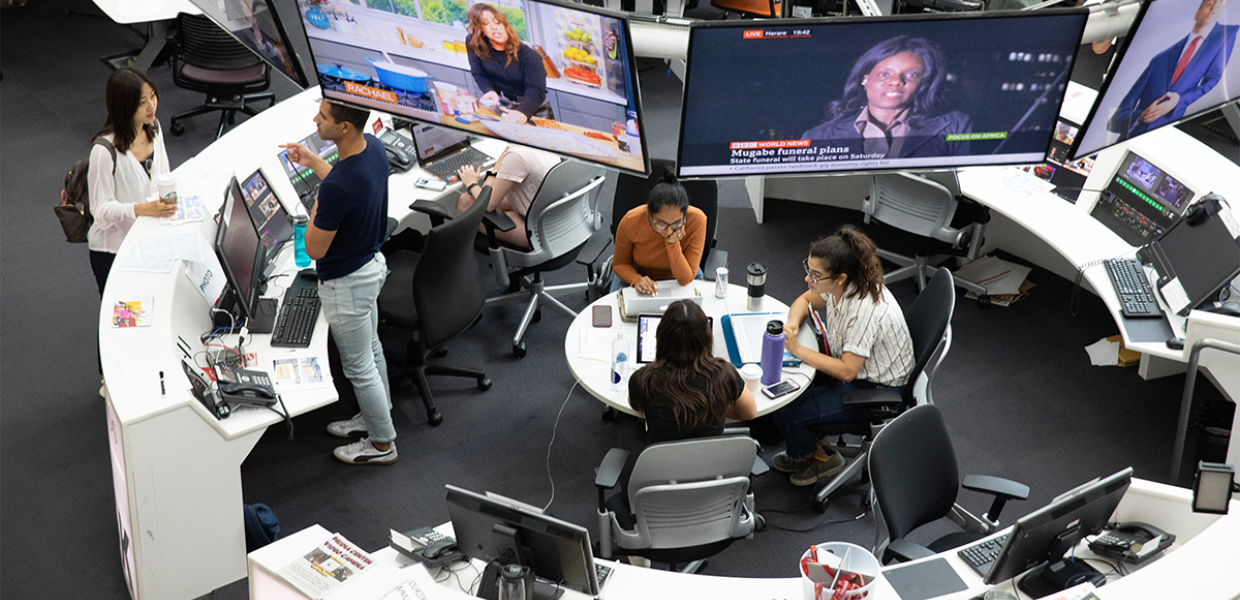As she prepared for her Zoom call with two of the editorial leaders of The Day newspaper in New London, Connecticut last Spring, Taylor Mills couldn’t help but be nervous. After all, she and her partner were about to point out flaws in the paper’s website and social media.
“I was scared we would seem insensitive — the idea that students who are going to a university across the country think that they know it all,” said Mills, a junior journalism major.
But as she and Jean Daniel LeRoy, a senior at the USC Iovine and Young Academy (IYA), shared their plans to punch up The Day’s social feeds with infographics to drive reader engagement, Mills was relieved to find the paper’s editors receptive. “They really welcomed our input,” she recalled.
Mills and LeRoy’s collaboration was part of the “Advancing Journalism with Human-Centered Design” course that anchors the News and Information Innovation minor. Launched last year, the minor combines USC Annenberg’s journalism expertise with IYA’s entrepreneurial approach to design and technology.
“There is a deep need for innovation in newsrooms,” said Laura Davis, associate professor of professional practice of journalism at USC Annenberg. “Given all the possibilities in the current media landscape, we have a tremendous opportunity to rethink how we present and distribute factual, reliable information. And that's what this minor is designed to capture.”
Open to all USC students, the minor so far has mostly attracted USC Annenberg and IYA students. Rebecca Haggerty, associate professor of professional practice at USC Annenberg, remembers having discussions with Davis about how to build a class that teaches innovative design in newsrooms.
As the idea for the course began to take shape, Davis realized that IYA would be the ideal partner. Founded in 2013 with support from Andre “Dr. Dre” Young and music producer Jimmy Iovine, IYA brings together multiple disciplines to teach creative problem-solving, often through practical collaborations with big-name brands. “They have expertise in the process of innovation,” she said.
In 2019, Davis connected with Matthew Manos, IYA’s associate director for special projects, to develop a class around the intersection of journalism and human-centered design. Their idea burgeoned into a minor based on that same interdisciplinary approach. Davis and Manos created the syllabus, while Haggerty shepherded it through the curriculum committee process. Both schools voted overwhelmingly to approve the News and Information Innovation minor beginning in the 2020-21 academic year.
“The minor combines all of the energy and the maker ethos of IYA with the really terrific journalism credentials of Annenberg,” Haggerty said. “Our hope is that students will understand what it means to be a journalist, while also thinking about creative ways to distribute good journalism.”
The minor, which is formally housed at IYA, consists of two new classes — “Advancing Journalism with Human-Centered Design” and “Designing Narrative Media” — as well as one other required IYA course and two other required USC Annenberg courses, with a broad selection of electives from both schools available.
Davis and Manos first taught the “Advancing Journalism” course in Spring 2021, but, due to the pandemic, not in exactly the manner they had planned. The class was originally designed to be very hands-on and based in USC Annenberg’s Media Center, with IYA students embedded with journalists, talking to editors and observing the process, Davis said. But since the class had to be remote, they instead connected the students with professional newsrooms around the country.
Students were assigned individually or in two-person teams to five local newsrooms. Consulting with the local journalists, the students would identify a problem to solve, and then come up with a solution using the human-centered design process. They then pitched the solution to the newsroom leaders at the end of the semester.
“We needed to pivot, but it became something really great,” Manos said. “The students confronted real challenges that local newsrooms across the country are facing. And that was really exciting.”
As valuable as the experience with the news professionals was for students, Davis said she’s excited that the “Advancing Journalism with Human-Centered Design” course offered in Spring 2022 will get students into the media center and immersed in the hands-on practice of a newsroom. “It’s not just about the output — the content, what the audience sees — but also about the inner workings of newsroom processes,” she said.
Manos added that he hopes the class, and the minor as a whole, can get non-journalism students excited about the news. “They should see it as a space to innovate, where they can advance the critical importance of that field — while also picking up some skills they can apply to other disciplines,” he said.
When LeRoy took the course, it wasn’t his first experience with USC Annenberg faculty. He had worked for a year at Crosstown, the data-driven news site operated in partnership by USC Annenberg and USC Viterbi. “I already knew I was interested in civic tech, journalism and storytelling, so I found this class really interesting,” he said. “It filled in a lot of the context about how journalism is fundamentally a set of principles, independent of any particular format.”
The project for The Day newspaper was a microcosm of how the class was intended to work, combining LeRoy’s design skills and Mills’ journalism training. “We became these design strategists building bridges between the needs of people and the needs of business,” LeRoy said.
Mills said that the minor promotes exactly the kind of entrepreneurial thinking that the media industry needs to help it connect with today’s audiences. “Writing articles is something that I'm good at, but is that what people are typically engaging in? Not really,” she said. “You hear a lot of talk about the harsh realities of how journalism’s business model is not strong enough. But when you bring in the design approach that IYA offers, you realize that journalism just has to reinvent itself to remain relevant.”
